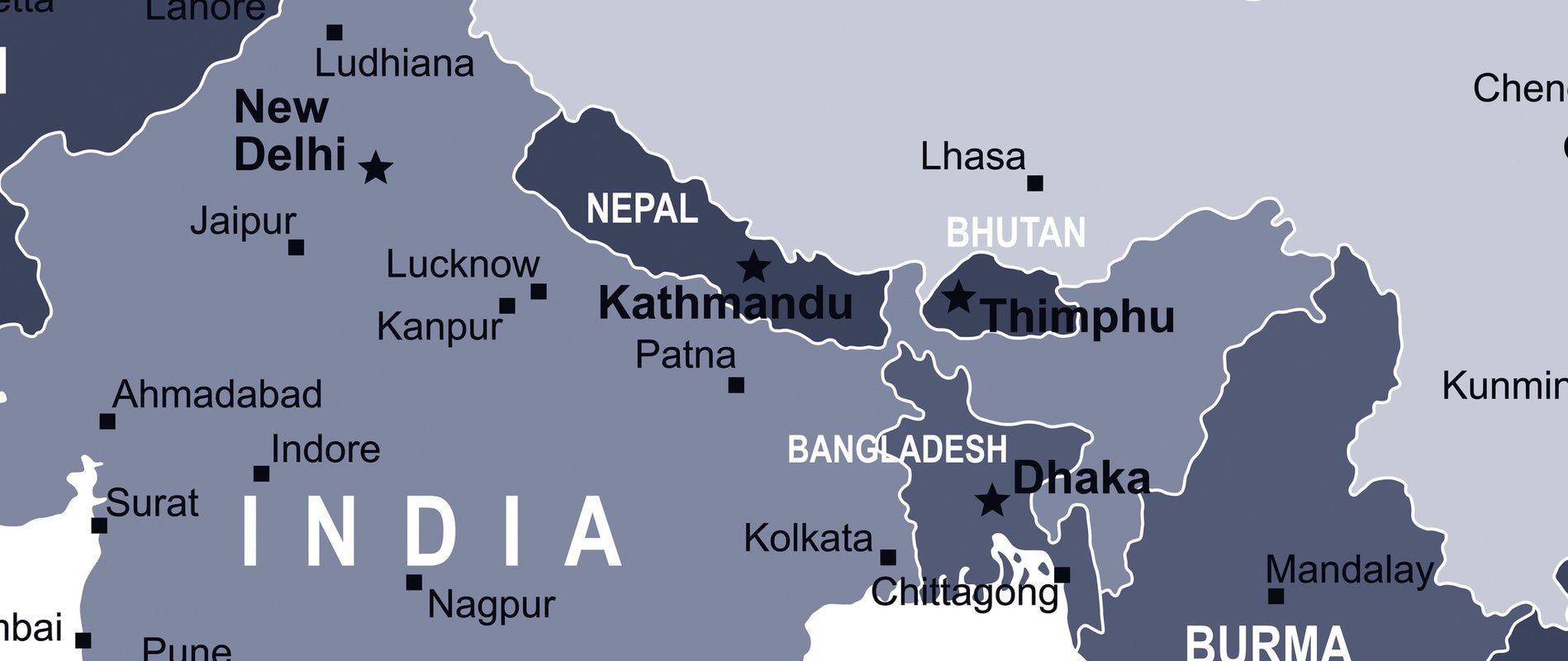William S. (Bill) Carter, CIH, PhD, an AIHA member since the mid-1980s, is professor emeritus at the University of Findlay in Findlay, Ohio. Carter taught in the university’s environmental, safety and occupational health management program, which he directed for about five years, from 2006 to 2011.
The master’s degree program at the University of Findlay attracted many international students, including several individuals from China and South Asia. At the suggestion of one of his Nepali students, Carter began investigating the possibility of teaching at Kathmandu University, where the student had completed his undergraduate degree. Carter applied to teach in Nepal as part of the Fulbright Program and was soon accepted. In 2009, he and his wife traveled to Nepal, where they spent more than six months while he introduced the first course in occupational health in Nepal as part of Kathmandu University’s environmental science and engineering program.
Carter is a member of AIHA’s International Affairs Committee and is the association’s ambassador to Nepal.
The Synergist: What are some examples of IH-related projects going on in Nepal?
Bill Carter:
While I was teaching at Kathmandu University, I worked with several students who were interested in issues associated with reducing exposure to the smoke from cook stoves, but probably my most satisfying work was with one of the undergraduate students. He and I monitored the metropolitan traffic police in the Kathmandu Valley. Since there is a limited amount of electricity—sometimes as little as eight hours a day—the traffic police have to stand on every corner to direct the traffic of the buses, lorries, and many, many motorcycles on the major roads. We monitored both the dust and the noise and verified that indeed the traffic police were exposed in excess of the ACGIH standard. We also discovered that there was a significant amount of silica in the dust in the valley, and that led us to encourage the people at Kathmandu University to look further in terms of some of the dust monitoring they’d been doing.
Meanwhile, the folks at Kathmandu University became interested in doing some additional dust monitoring, particularly in the brick kilns. There are probably about 450 brick kilns in the Kathmandu Valley and maybe as many as 800 or 900 in the country. In the brick kilns, as one can imagine, there is a lot of dust. It is an industry that employs primarily migrant workers, who are workers of the lower caste, called dalit. They are people who come from remote parts of Nepal or India, and in many cases they bring their families. There are certain indications that at least some of the family members, including children, end up doing some of the work. We have some evidence that children as young as 12 are carrying these bricks and are exposed to the dust. It turns out that silica dust and exposure to silica can lead to early-onset tuberculosis, so there’s some causal relationship we’re looking at to see whether we can identify conditions of early exposure. We’re hoping that we can figure out ways to reduce the exposure of children and perhaps all workers in ways that are cost effective and appropriate, both culturally as well as economically.
I was just back in Nepal for about a month, giving a couple of lectures at Kathmandu University and collecting and bringing back samples associated with the dust and silica samples that have been collected at the brick kilns. We have an unanticipated but perhaps fortunate comparison: my associates over there, Dr. Sanjay Khanal, and a PhD student, Seshananda Sanjel, had collected samples last year prior to the earthquake, and they have since gone back and sampled at the same kilns that had to be rebuilt after the earthquake. We’re hoping that eventually we’ll get a comparison pre- and post-earthquake. Among other things, the tall chimneys, or battas, were rebuilt differently than before. Now they’re shorter and perhaps a little more squat. It’ll be interesting to see whether there is a difference, particularly in the emissions from the chimneys of the kilns. However, there might also be some indication that when they reconstructed them, they made them more energy efficient. The very preliminary indication is that they may have reduced the amount of fuel the kilns use by as much as 25 percent. That’d be very striking. You know, you’re not able to control all the parameters in every research project you do, but you can take advantage of a change in variables when they happen.
TS: How is Nepal recovering from last year’s devastating earthquake?
BC: There’s no question that they’re still recovering. It turns out that there were about eight areas in the country that were affected. It’s not that many areas, but there was dramatic devastation where they were affected. For instance, we went to an earthquake refugee camp that had been set up by the Portuguese that contained about 30 tents. The men were back in their village, Sindhupalchowk, which is probably 80 kilometers north and east of Kathmandu, trying to rebuild while the wives and mothers stayed at the camp. They were making bags and envelopes out of newspapers, decorating them and selling them as a source of funding. The children were just finishing the school year. My grandson, who went along on this part of the trip, brought toothbrushes and toothpaste to hand out to the young children there. Before we left, we saw the children in front of the water spigot brushing their teeth. That’s an example of an entire village, but some of the areas have been more readily photographed such as Kathmandu itself or Bhaktapur, where there was quite a bit of damage to major temples and historic sites, and literally whole blocks of buildings collapsed.
But they’re making progress. There are pictures taken right after the earthquake where it was simply a pile of rubble, and now they’ve cleared the rubble away and you can see the outline of the streets. They are taking every usable brick, strut, and pillar, washing them off, and they’re going to rebuild. They’re not waiting for the government. At this point, the government has only allocated maybe $1,500 per family to rebuild a house, so they’re doing it on their own. The Nepali people know how to pick themselves up and rebuild their lives. They’re hardworking, very intelligent, and very industrious. I am still enthralled with our experience in Nepal.
Editor's note: This article is part of a new Synergist series called “Pole to Pole.” Exclusive to the digital magazine, this series focuses on how industrial and occupational hygiene is practiced around the world. Each month, the digital Synergist will feature an edited Q&A based on an interview with an industrial hygienist about how the IH/OH profession differs from country to country. The
previous installment
of “Pole to Pole” features AIHA member Jas Singh, who discussed IH in Malaysia. This month, the series focuses on Nepal.|
Pole to Pole:
Nepal
|
An Interview with Bill Carter
"Sometimes in the high-tension industrial world in the States, we fail to realize that you can’t solve all of the occupational health problems; there are always more to come, and certainly in the developing world, there are lots more to come."
-Bill Carter
Bill Carter and his wife, Lael, at Patan Durbar in Nepal.
TS: What are occupational health and safety regulations like in Nepal?
BC: They have a labor law, and the one chapter concerning health and safety has 10 paragraphs. As I wrote in a paper published in 2010 in the journal of the British Occupational Hygiene Society, in Nepal and other underdeveloped countries, we really need to think not in terms of compliance as we do in the United States, but in terms of conformance.
For example, several years ago, I got involved with the GoodWeave organization, which works to reduce the use of child labor in the carpet-weaving industry. Working with GoodWeave, we helped them write a health and safety policy that was then voluntarily adopted by the owner-operators, who recognized that it would improve the health and safety of their workers. In the case of the carpet weaving where you’re using wool, the wool dust produces signs and symptoms similar to byssinosis, which is caused by inhalation of cotton dust. There are simple ways to reduce workers’ exposure to that dust, including making sure that you remove the dust on a daily basis so that it doesn’t accumulate on surfaces. Now that’s part of the inspection process by the GoodWeave organization in the carpet-weaving industry in Nepal.
TS: What are some major cultural differences that IHs who have never worked in Nepal can expect to find?
BC: Well, there are some wonderful cultural differences, but there are also some challenges. To me, one of the most wonderful cultural differences is their attitude concerning religion. In Nepal, they say 85 percent of the people are practicing Hindus and 60 percent are practicing Buddhists. There’s a very blurred line in terms of religious practices, and the attitude with the people there is “whatever works for you is fine” as opposed to “this is the way you have to believe,” and that was a wonderful awakening experience for me.
One downside, if you will, is that time is not necessarily important, at least in the way we think of it in the U.S. In Nepal, if you can do it today, you’ll do it tomorrow. And if you can’t do it, the phrase is “ke garne?” which means “what to do?” And with that, you sort of nod your head from side to side: “ke garne, what to do?” There’s a much more laid back attitude, and you need to take off that rigid coat of thinking and just enjoy.
You’ll also find some differences in getting around. As you’re standing by the side of the road, it’s common to see the buses going by jam packed with people, with at least three passengers leaning out the doors. And if you look up on the roof of the bus, you might see six or eight goats tied down going to market.
Of course, the vehicle of choice is motorcycles; there are probably 30 times as many motorcycles as there are automobiles because petrol—gasoline—is much more expensive since it has to be imported, mostly from India. They also drive a la British style, so you have to get used to looking in the opposite direction. And soon you learn to walk out in the middle of the road, put your right hand out and wave it a little bit, like a queen’s wave, to say, “Hey, I’m here, don’t run into me.” You just have to be careful when you’re walking on or across the roads.
If you want to have an adventure, there are plenty of opportunities to do multi-day treks into the high Himals, whether it be in the Annapurnas or up toward Jumla and the base camp of Everest. Nepal is a beautiful country, with seven out of ten of the world’s highest mountains and lowland jungles with tigers, wild elephants, and a myriad of birds.
TS: What can young professionals learn from working in a country like Nepal?
BC: For every young person who is trying to figure out what they’re going to do as an industrial hygienist, doing a project in a developing country will make them aware and perhaps even tolerant of what can and cannot be done. Sometimes in the high-tension industrial world in the States, we fail to realize that you can’t solve all of the occupational health problems; there are always more to come, and certainly in the developing world, there are lots more to come.

thesynergist | TOC | NEWSWATCH | DEPARTMENTS | COMMUNITY

